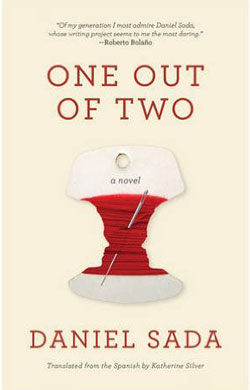One Out of Two
by Daniel Sada, translated by Katherine Silver
reviewed by Michael Broida
Gloria and Constitución, the Gamal sisters, have been identical and inseparable for their entire lives, or so Daniel Sada posits in One Out of Two, published in 1994 and recently translated into English. Sada deconstructs this identity to its pure core, asking the reader to consider just what constitutes a person: “Two different beings, two ideas, two premises in search of unity. . . their laughter was their tears turned inside out by the terrible truth that they looked so much alike, that they could never be otherwise.” Gloria and Constitución find themselves caught in the awful crux of Platonic love, as described in The Symposium: humans were once powerful beings with four arms and four legs, but the gods felt threatened by humanity and split them in two, causing modern humans to constantly seek their other half. Sada’s story lives in the duality of this impregnable bond: Gloria and Constitución are one spirit in two separate bodies, desperately trying to pull themselves apart.
Duality and duplicity are central to Sada’s novella, where one statement often has two meanings or one event has two different sides. Tragic moments are turned comic by his breezy narrative style. The blasé and lackluster way their aunt tells them how they were orphaned edges on the absurd: “‘Your parents were killed in a highway accident. Apparently, it was horrible, according to the report, their heads got severed, but they were identified anyway.'” Sada leaves the reader little time to dwell on the gruesomeness and horror of the moment, and the recitation becomes doubly humorous and horrendous, and this, ultimately, is the chief duality in One Out of Two. A novel at once silly and colloquial and nominally about two identical sisters who trick a man into dating them both at once, it is also fundamentally about loss, isolation, and loneliness.
In his native Spanish, Sada, known for his playfulness with language and colloquialisms, is often compared to James Joyce for the way he manipulates language and structure. Although he died in 2011, many of his novels are still finding their way into English, mostly recently Almost Never in 2012. In Mexico, his 1999 novel Porque Parece Mentira La Verdad Nunca Se Sabe (Because It Seems A Lie The Truth Is Never Known) is considered seminal for its inventive use of Spanish. One Out of Two‘s translator, Katherine Silver, also translated Almost Never, doing a valiant job of bringing Sada’s rhythms and nuances into English, breaking and bending traditional rules of grammar and punctuation to bring Sada’s style to the fore.
Throughout the novella, Sada weaves a dense web of informal language that turns quickly from silly to tragic. When Constitución leaves her sister to attend a wedding, Sada pours Gloria’s loneliness of sitting in their shop onto the page: “…and a quick return to take a look around the work space: a concrete desert filled with squalor and lacking air. Nascent longing and the word absence seeping in the sewing machines.” A little shop that was once vibrant with her sister becomes rife with destitution and longing, the verb “seep” fitting in perfectly to show the sinking feeling of Gloria realizing what it means, for the first time in her life, to be truly alone, to feel “absence.” Just as quickly, Gloria’s mind turns to how it might be to find and kiss some hypothetical man, something she has never done, and here Sada channels the fantastical nature of such an endeavor: “Yes, then a sequel with a smoky hue, a pursuit, and proximity: melting into an illusive silhouette of passion and desire: hence, only a tiny taste of satisfaction. Insinuations of such vast pleasure! How unattainable, for both of them!”
One Out of Two, in its bare bones, is a fairy tale: two girls orphaned at a young age work as seamstresses until they undergo a courtship that could change their lives and lift them out of their current station. In this, Sada pushes the limits of both the language and the story. The lives of the Gamal sisters are at once humorous and deeply tragic: the two women struggle with their arrested development, their rejection of love, and their unquenchable desire to return to their simplest adolescent comfort—each other.
Published on January 16, 2016

